Question
Apoptosis is programmed cell death. Apoptosis is often triggered by mutations that could cause a cell to form a tumor if the cell continued to grow and multiply.
(a) Describe the organelle in a eukaryotic cell that is most likely to participate in apoptosis.
(b) Explain other functions the organelle from part (a) would have in the cell besides participating in apoptosis.
(c) A mutation causes the enzymes in the organelle from part (a) to become nonfunctional. Predict what effects this would have on the cell.
(d) Justify your prediction from part (c).
▶️Answer/Explanation
Ans:
(a) The lysosome is most likely to participate in apoptosis because it
contains hydrolytic enzymes that can break down parts of the cell.
(b) Other functions of the lysosome are to assist in digestion by
breaking down large macromolecules and destroying bacteria or
viruses that invade the cell.
(c) The hydrolytic enzymes in the lysosome are crucial for the
functioning of the lysosome. If those enzymes were not functional,
the lysosome could not perform its activities, thus reducing, or
even preventing, the cell’s ability to function.
(d) If the hydrolytic enzymes were nonfunctional, the lysosome could
not assist in digesting large molecules nor could the lysosome
break down waste products in the cell. The cell could
simultaneously starve, since it couldn’t digest its food, and be
poisoned by its own waste products. In addition, the cell’s ability to
defend itself against invading pathogens would be compromised.
Question
The following data were collected by observing subcellular structures of three different types of eukaryotic cells.

Based on an analysis of the data, identify a likely primary function of each cell type and explain how the data support the identification.
▶️Answer/Explanation

Question.
In eukaryotic cells, ribosomes are found both free in the cytosol and attached to the endoplasmic reticulum (ER). Proteins produced on the attached ribosomes are delivered to the ER, while proteins produced on free ribosomes are delivered to the cytosol. Briefly explain in one or two sentences the two processes in terms of the following:
• ONE ultimate destination of a protein produced on an attached ribosome, and ONE general function of the protein (You do not need to identify the specific protein.)
• ONE ultimate destination of a protein produced on a free ribosome, and ONE general function of the protein (You do not need to identify the specific protein.)
▶️Answer/Explanation
(a)

(b)
